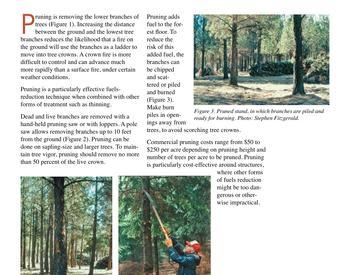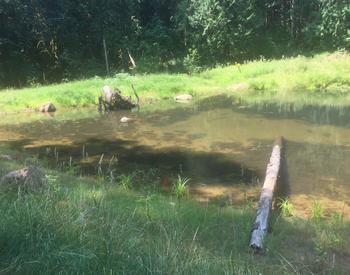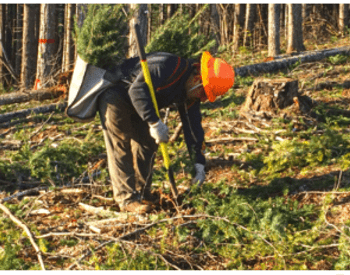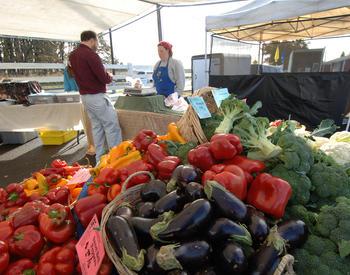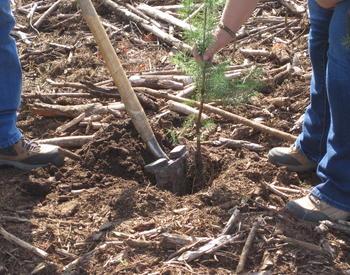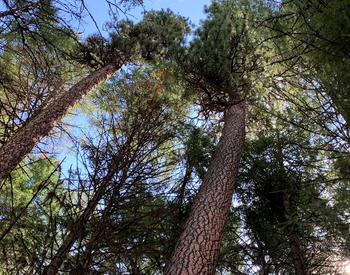Transcript
From the Oregon State University's extension service, you are listening to In The Woods with the forestry and natural resources program. This podcast aims to show the voices of researchers, land managers, and members of the public interested in telling the story of how woodlands provide more than just trees, they provide interconnectedness that is essential to your daily life. Stick around to discover a new topic related to forests on each episode.
Welcome back to another episode of In The Woods, I'm your host Lauren Grand, assistant professor of practice and extension agent in Oregon State University's college of forestry. Today's topic is non-timber forest products, or what some people would call special forest products. Our guest today is Neil Schroeder. Neil is a man of the woods, he's been working in the woods since he was 14 doing every job you can think of that happens in the woods. He recently retired as a forester and now he focuses on non-timber forest products. Him and his family are part of a cooperative in Oregon that work together with other small landowners to help provide non-timber forest products and really make a business out of it. Welcome Neil, first, I want to learn a little bit more about you. Okay, all right I'm Neil, Neil Schroeder, my family owns about 300 acres of timberland in northwest Oregon, my father was a forester and, therefore, I grew up knowing a little bit about forestry although I became a math teacher and after my father died.
This organization that he started the Oregon woodland cooperative asked me to participate and since we still own the timberland that father and I bought, we decided that we would certainly join, and at one point I became president of the organization and at that time there were about 50 members and we were barely making a profit if any profit at all during the this time and now we represent about 80 members and about 35,000 acres of timberland in Oregon. So, I guess that gives you some idea of why I know something about forestry and the products that we produce as a result. Okay, great, so can you um tell us a little bit about uh what non-timber forest products are? Yes, when you are basically growing timber for the log market it takes who knows 30 to 50 to 100 years to grow a tree before you want to harvest it, and as a result you have to think of ways for your land to be profitable. And one of those ways is to thin as trees grow, but quite often when you thin you can't sell the logs because they're either too small or too imperfect or the prices for small logs has disappeared. And uh one of the problems that has occurred here in the northwest is that many of our paper mills no longer exist. Paper making has basically gone overseas and so we're no longer selling the kind of wood that normally made paper uh we have to find other uses for it, and then we got to thinking about what do we do to pay those taxes while the timber is growing? And one of the ideas we had was well when you thin a small log can be easily turned into firewood rather than just put on the ground and let it rot. And so we began to think about well how do you sell firewood and make a buck? Everybody knows that every time you turn a piece of wood it costs you money. So, the idea is to be able to figure out a way to handle the wood the least amount of time and the least number of times and still make a dollar. So, one of our
opportunities was to obtain a USDA grant and when we did that, we hired a person who knew something about non-timber forest products, a person who was a a marketer and salesman, and a person who could manage much of what we were doing. And it was very fortunate because the non-timber forest person had several good ideas, the marketing person said what about bundled firewood? And he went out to the new season stores in the Portland area and found that they wanted to sell bundled firewood that they would be willing to sell our bundles for $3.50 to $4.00 per bundle when the competition is selling theirs for $2.00 to $2.50 per bundle. And this was one of our opportunities and then we began to look at other opportunities. Well, one of our members happened to have a old Christmas tree farm and that Christmas tree farm was still producing beautiful boughs and we found we could sell directly to the florist shops without going through the uh wholesale houses. And that again was another way we could make a buck and then um one of our members also thought about other things that we could do and we came up with a whole lot of ideas, but what we found was that unless we had one member or two members willing to run with an idea, it was very hard for one or two people to take all of the ideas and find a way to make a buck with all of those different things. But there are so many things produced in a forest that it just boggles your mind because if you think of the forest as a tremendous chemical factory a tremendous wood factory a tremendous water factory
you just have to think of the right things of what you might do. And there are just so many things that we could possibly sell but we need people who are willing to market and sell them, but right now we are selling boughs and we're selling uh firewood bundles and doing very well with it. So, any other questions? Sure that's great, so it's good to hear that um you're doing well and you have a couple of products that you found a good market for. So, you're referring to um a group by we a lot and um, I guess I should have asked you this first, but do you want to tell us who um the Oregon woodland co-op is? Yeah, the Oregon woodland cooperative was started in 1980 and '81 actually incorporated in 1981 by um Barney Donine and George Schroeder and they put together a group of about 20 landowners I think maybe 12 landowners to begin with representing about 10,000 acres of of timberland and uh their purpose was at that time to find a way to improve the marketing of the logs that you could sell. For instance, if you went to a mill in 1980 with and you had only a couple of loads of logs to sell, you might not get a very good price. But if you represented 10,000 acres of property and timberland then the mills might decide well we'll get a lot more business from these people maybe we'll give you a good price. So, that was one of the reasons for starting the co-op. The other reason was that and it still happens there are people who are less than honest and will offer you dollars for your timber and you might take those dollars and find out later that your timber was worth a great deal more, and the purpose then became to protect that group of co-op members in such a way that they would learn the values of their property. So, they hired a full-time forester to work for them who uh would give them time on their property and give them some value information and keep them from making those terrible mistakes that can hurt your pocketbook so badly. That was its original intent and as the years went on and more members came along the concern became well how do you pay those taxes while the timber is growing? And that's when we got that usda grant to explore those possibilities. And uh we now are doing not only selling timber, but we are selling services and we are selling products from the forest and, in addition, we recently became distributors for super split log splitters and log right forestry tools. Now, super split log splitters are a kinetic splitter that uh is about five times faster than a regular splitter, and this we found was incredibly valuable for making bundled firewood because not only is it fast but it allows you to cut very small pieces, or very thin pieces, so that you can make your bundles look much better than the competition because you can fill all those voids that your three-quarter cubic foot bundle uh will look much better and it'll be a solid piece instead of one that kind of falls apart when you pick it up. And because our bundles look better than anybody else's we command a much better price. So, that gives you a quick overview of why the co-op exists uh we intend to offer more services and hopefully more products as time goes on and uh there are so many talented people now in the organization that it'll very quickly I'm sure we'll find some great things happening with the co-op.
Wonderful, so it sounds like your organization plays a vital role for small woodland owners. You offer landowner education on forestry management on things other than timber production , you help landowners with income development through economies of scale, and you also make your products
do better than the competition by making sure that you have a set rule of um protect production. You have a, what's the word I'm looking for, you have production guidelines to make sure that things look good and people want to purchase your products. Is that right? That's correct, yeah, um what we have done whenever we do come up with a new product idea we first of all write a protocol for how it should look. And the reason for that is that we don't have any bricks or mortar that is we don't own any specific location. We work out of our homes and if we sell a bundle of firewood to one store from one producer then the next bundle that goes to the next door should look the same and that's the reason for that protocol. Our firewood protocol basically says that it will be within a half an inch of 15 of 16 inches plus or minus, it'll be less than 18 uh moisture content, it'll be clean, and it will be a full three-quarter cubic foot bundle with our label on it. And we now have about 15 to 20 people at any given time who are bundling firewood but every bundle looks very much the same and that's what we were striving to do. And we do the same with uh anything that we sell. We did sell for a while um
essential oils and that grew into a business and we sold that business to one of our members, and uh even that had a specific protocol we wanted everything to look the same we wanted it to come from the same sources we wanted to look uh consistent so that one store buying it would get the same product that the next store buying it would get. But we are coming up with new ideas also, for instance, um one of our members of, John Belton was his name he's no longer with us, but John and Carol uh found that we could sell direct as opposed to going through middlemen and so many of the products that we work with now we use his concept of selling directly to the end customer so that you eliminate selling to wholesale houses at low prices.
Kind of gives you an idea of of our methods and our protocols and what we're after. Great, that's important to hear so the take some thought to and business business-wise to be able to get these products off the ground.
So, you mentioned a few products you mentioned essential oils and firewood and boughs but even if you don't you your group itself doesn't produce them what are some other popular non-timber forest products that landowners might be interested in either looking into for a business or even just a hobby? Well, think of our 80 members. If you, um, who buys timberland anyway? Well you find out that it's it could be a logger that buys timberland it could be a forester it could be a veterinarian it could be a doctor it could be a salesman.
All of those many people have different backgrounds and different ideas of what they like and what's important to them. And we found that one of our members again was very interested in truffles and that idea has grown and I recommend to anyone who is interested in truffles that they pick up the latest edition of the Smithsonian magazine. There's a delightful article in there that
explains the possibilities of what one can do with truffles. Now, a truffle is a mushroom that grows underground if you will and it grows on the mycorrhizae of Douglas fir and on the mycorrhizae of several different plants. The most uh well-known in Spain for instance and France is the black truffle that grows on oak mycorrhizae. And uh it is a interesting, wonderful uh mushroom because the chefs love it and it uh adds flavor to any uh menu that you might be putting together. Well, one of our members has trained dogs to hunt for for truffles and she has actually won the dog trial recently uh in training dogs to hunt truffles, but there's a tremendous amount of value in truffles if we can solve some of the problems. And one of the problems of course is how do you protect your timberland from the person who decides that they can hunt truffles on your land and don't ask for permission. That's one of the big problems. The other is, is there a way to actually promote the growth of truffles? And that's what where the Smithsonian magazine comes in. Take a look at that it will tell you that some people are beginning to do that. So, that's one of the products. Others are plants! My goodness, uh, we could sell plants to nurseries. One of our members again sold several thousand sword ferns to the landscaper who did Bill Gates' new house several years ago and continues to produce sword ferns in his nursery. And there are so many beautiful native plants out there that uh many of those can be sold in addition to holiday boughs of course. So, there are many many products the um if you recall the forest shops often have beautiful greenery well much of that is Salal and Salal can be harvested along the coast particularly because the leaves are so shiny and beautiful and add to any floral arrangement that you make. And that kind of leads to what about things like salal berries salal jelly by the way is absolutely wonderful if you haven't tried it, I recommend it, and uh of course there's huckleberries and elderberries and all of those that can be made into... I have to tell you I was at a, sorry to interrupt you, but I have to tell you that I was at a fair once and the first time that I ever had salal berries was from a very kind gentleman who uh offered me some fruit leather made from oh native berries and the main berry was salal berry and it was I was hesitant at first but it was delicious. Oh, yes. Now, I'm now I'm much more open to forest foraging for forest berries. Yeah, well there are so many opportunities out there and as I said it really takes somebody who really wants to run with it. I found that Port Orford cedar for instance the essential oil and Port Orford cedar is the same aroma as the wood that is used for the temples in Japan. And so I found a person who is distilling sawdust from Port Orford mills and selling the essential oil that is resulting to Japan and making quite a bit of money as a result. Another product that we are actually selling in one way you think about our membership again several of those members are wonderful artists and they are painting um scenes of the woods and selling those paintings, but they're also producing things like baskets made from cedar bark or from spruce roots if you will. They're making candles they're making all kinds of things that use a forest theme or they're turning beautiful woods if you think of madrone wood as just a firewood it's a beautiful wood for making different furniture and flooring and that's another product that one of our members actually has a tremendous business of making flooring from hardwoods in Oregon. So, they're just a whole lot of products it's just finding the people who are willing to run with the product and get us to the point where we're all selling it in one way or another. My goodness there's so many great products that you just discussed it sounds like if you have an imagination you can come up with something. Yeah! Other than timber in your woods. Oh, absolutely. So, you know you talked a lot about these different products and you know some of them I've just heard for the first time, so it may be occurs to me that these non-timber forest products are not very common in the pacific northwest, or is it just an underground industry that a lot of people don't hear about? I think more like the second um and I think as we begin to study more in depth what the Native Americans did with all of the products they gathered within the forest, we'll find things that we can sell and sell efficiently and learn from it and perhaps improve our total ecology as a result because we'll take more care in taking care of all of the products that are out there. There's so much that can result when you really start studying what's under the forest canopy.
Sounds so exciting like there's a treasure map out there to follow. Yes, that's well put.
So, this is so exciting so we've heard lots of terms thrown around um we're talking about non-timber forest products, but maybe some people have heard about agroforestry or forestry farming. Can you talk a little bit about how this is different? Yeah, um, we're finding that you know as you thin a forest you open up the forest floor for other purposes perhaps grasses will begin to grow, more light will get down to the forest floor, and it's possible that you can grow different things in addition to the timber under that canopy. The shade loving things for instance might do very well and people are now exploring the idea of and of course this has been done for years you could animals have grazed in the forest for years and the forest service does issue leases for grazing so that's one way that you can use agroforestry. Another one, a friend of mine, a retired veterinarian, has found that he can grow several different plants and sell those plants and the fruit from them under the forest canopy.
And I've forgotten just exactly what his total output was, but some of the things were uh plants from Australia that he was able to get to grow in under his forest canopy and was able to sell them. Okay, so, I think i'm understanding the difference. So, is agroforestry and foreign forest farming sort of like a planned field underneath the canopy of your trees? Yes, and I attended a farm forestry uh conference uh COVID-19 kept me from doing it this year, but it was a year ago February in Canada. And there they were actually planting trees in rows and planting crops between those rows that they could harvest readily. And, so, as the trees grew, the land was producing a yearly crop in addition and they called that agroforestry. So, it might be something as simple as hay or wheat that was growing between the the timber rows. Another example um one of our mentors in the essential oils, Robert Seidel, who happens to own the company called the Essential Oil Company has traveled the world uh consulting with essential oil producers and he found in Brazil a farm that was farming eucalyptus. And eucalyptus is unpredictable, it doesn't always grow straight, sometimes it does. Well, what they were doing they were growing the eucalyptus in rows they were making charcoal out of the limbs that didn't grow straight, and they were making essential oils out of the uh leaves, and when they made charcoal, they did it the ancient way where they would pile up a huge pile of brush and then cover that with mud and then start a fire inside. But they had a vent pipe of a big long steel vent pipe that went at an angle out of the top of this huge mud hut if you will and at the bottom of that pipe was a bucket. Well, as the smoke went up that steel pipe it condensed and the condensed smoke became turpentine and the terpenes that are created in the smoke of eucalyptus. And they were selling they were selling lumber from the straight logs they were selling chips from chipped logs they were selling charcoal they were selling essential oils and they were selling terpenes. All from one farm and that I would call agroforestry. That really gets to the definition of using the whole product right? Yes, yes. So, it sounds like there's a lot of opportunities for people to get into non-timber forest products... Yes, you know there's another non-timber forest product that I know is very prevalently used in the south particularly and that is to lease your land for hunting. Or to lease your land for camping and that's another possibility. That's a great idea! Especially if you know you know that you have a lot of huntable animals on your property and that's not really a hobby of yours. Well I know that uh some of the large timber companies are already doing that here in Oregon. Right, okay, so um these are great opportunities for people to be creative and think of other ways that they could potentially make income to help pay the bills in between harvesting rotations. We talked a little bit about this uh but what are some of the barriers for being involved in non-timber forest products? What might people need to think about before they get dive right in head first? Um, some of the barriers basically would be your own individual attitude. Um and what I'm getting at is some people will say, "Oh I've got this great idea!" And they would buy equipment and start doing things that uh were expensive and then find out that the product they thought would just do very well never did. So, that is a barrier in in that you've got to be careful to plan ahead. An example I give is a friend of mine bought a laser cutting machine. It was a wonderful machine, it would etch glass and his idea was that he could do shower stalls and and windows that had beautiful designs on them. Um but he never marketed it, and as a result, that fifty thousand dollar laser machine uh he eventually sold for twenty thousand. And I don't think he really made very much out of it at all. So, my concern is be careful, plan ahead, do some market study, put together a market plan before you decide to jump. There are a lot of barriers and they're mostly financial. Um don't buy expensive equipment without knowing what you can do with it and that it will pay for itself.
But do think seriously about what can be done and share those ideas with somebody who is willing to do some marketing and thinking about how to sell it.
That makes a lot of sense you don't want to put a lot of money into something that you're not sure will bring back the investment plus some. Another example I could give you um the same fellow John Belton thought that he could sell stair treads and so he started producing beautiful cedar stair treads. Well, most flooring companies don't touch cedar and so his idea was fine, but
cedar is not used for stairs because it wears so quickly. And uh you he just didn't think that through clear to the end that was one of the things that he thought many things very well but that was one that didn't do. But another product that he came up with that he did very well with he took those that same cedar lumber and simply made a piece that would have been say an inch thick by uh two feet long and uh probably eight inches wide and he sold that to his local restaurant as a salmon plank. And if you think about it a lot of people like to cook salmon on wet cedar planks, and that's basically because that's the way the Native Americans used to do it and it makes a wonderful uh meal as a result and he sold a single piece of wood like that for five dollars each and he sold many of them. So, there again is another product that can come out but it was through the idea of thinking about what can possibly someone use that I can produce. Cedar planks, that's brilliant. You know that's a a great way to make some good money pretty quickly, and it makes the salmon more expensive too. It makes everybody happy. John was a terrific guy there's so many ideas at the end that were wonderful. So, um, we're coming to a little bit of a close here, but before we do I wanted to just see if um the Oregon woodland co-op is open to new landowners? You know, if there's landowners out there that didn't know you you were around or do you mentor landowners who might be interested in thinking about non-timber forest products? Oh absolutely, yeah, we're always happy to uh find new members. One of the reasons that we are selling super splits is that we want to acquire new members and we give a member discount for anyone who buys us super split from us and joins the co-op.
So, we're very happy to get new people. The thing is that the largest forest cooperatives in the world are in Scandinavia. And um they now own sawmills and power plants and many of the products that come out of the forest are sold through those cooperatives. And each of the members makes money as a result of it, and so uh it's to our benefit to increase our membership. If we become large enough, it's entirely possible that we could begin to think about owning a sawmill or owning a
fiber producing plant of some kind.
Or, for that matter, a power plant. Who knows? Uh it it's possible if we can get the membership large enough with only 80 members there's not much you can buy each member contributing $50 a year, but if we had 800 members maybe we could think about some of those things. Right, stronger together right? Yeah. Great, so, that's a great summary on non-timber forest products is there anything else that you want to share with us that maybe we haven't been able to touch on yet? Oh, I'll probably think of something after we close. Oh, that's how it works every time. But uh no I just want to share some enthusiasm and uh let everyone know that this organization has been just great to work with because there are so many fine people who all have ideas and want us to be successful, and are willing to do the things that are necessary that we can put together a protocol and people will stick to it, that we can produce a product and folks will work hard. My goodness, last year we sold, a year ago, we sold 140 some thousand dollars of bundled firewood this year we sold $250, 000 and it's because so many people worked hard. I'm sure that the panic the pandemic had something to do with it because people are staying home and burning a fire in the fireplace maybe a backyard party where they couldn't go anywhere and they're going camping more too. But uh if we could just build on that enthusiasm and uh note that so many of these folks are willing to do wonderful things uh you you'd enjoy being a part of our organization, I can't say enough about it. That sounds good, sounds fun, I wish I had a forest so that I could start looking at what opportunities I had to collect things... Yes, yes. Okay, so this is the part where um I forgot to mention, so we do a little bit of a lightning round in all of our um podcasts and um they're pretty easy questions, uh, so don't worry about if you need to take a second to answer them. Okay. Um, it's mostly you know it's uh you know take your time and I can cut things out so don't worry about that um, okay, so there's only three and um they're pretty simple so I'll get started here.
Okay, so, uh Neil I'm dying to know since this is a forestry podcast what is your favorite tree?
Well, would you believe a copper beech? My goodness, I have not heard of this one. Can you tell me more about it? Well the copper beech uh beech trees are one of the form of a tremendous forest in Northern Europe. And uh they are just gorgeous, they grow straight and tall and their wood is beautiful doesn't have much pitch to it. And I particularly like the copper beach which is a subspecies of the beech genera because when it begins to leaf out it's almost pink, and as the leaves begin to come out they begin to darken in color and the tree is just absolutely beautiful. And then in the fall you get the reverse, the leaves begin to brighten from a dark deep uh magenta if you will to uh start to become more red and lovely. And this tree instead of being a big ball it grows straight and tall and that appeals to me. So, I guess that's one of the main reasons I like it. I gotta check those out I love trees that have that... Come out and visit us.
I have two of them here on the property, come on out. Okay, I gotta make my my way out there. So, you said you mentioned you own forest land right and um yeah sure you spend a lot of time out there, so what's the most interesting thing that you bring with you in the field? Whether in your field kit or if you wear cruiser vest. Huh, I'm not sure.
Much of our land is recently replanted because that way you could afford to buy it when it's bare land. So, much of what I do is in terms of improving the rate of growth and the thinning of young trees. So I don't know if there's anything in particular that I like to take with me but uh a camera is always very good because there's so many things happening out in the woods.
The camera is a great tool it sees what helps you see where you've been. Yes, that's right and it gives you a progress record over the years. Okay, and so my last question to you is what resources can you recommend to our listeners if they're interested in learning more about non-timber forest products? Or even the Oregon woodland co-op. Um well certainly go to the website of the Oregon woodland co-op and uh that would be one good way to learn what we're doing. Another would be to uh certainly Oregon State University uh department of forestry. Um Scott Leavengood I've forgotten how you pronounce his last name, teaches classes on non-timber forest products. And uh I recommend that you contact him or at least write to him to get some idea of what they are discovering now. There's hopefully always a new discovery. Okay, great, thank you so much we'll make sure that the website and Scott's contact information is in our show notes on our website. Thank you so much for joining me today it was really great to learn more about all the wonderful products that you guys offer and that people could potentially find in their woods. Thank you so much! You're welcome, my pleasure.
Thanks so much for listening, show notes with links mentioned on each episode are available on our website blogs.oregonstate.edu/inthewoodspodcast. We'd love to hear from you, visit the tell us what you think tab on our website to leave us a comment, suggest a guest or topic, or ask a question that can be featured in a future episode. And also give us your feedback by filling out our survey. In The Woods is produced by Lauren Grand Carrie Berger, Jacob Putney Stephen Fitzgerald and Jason O'Brien who are all members of the Oregon State University forestry and natural resources extension team. This podcast is made possible by funding from the Oregon forest resources institute music for in the woods podcast was composed by Jeffrey Heino and graphic design was created by Christina Fruehauf. We hope you enjoyed the episode and we can't wait to talk to you again next month. Until then, what's in your woods?
you
In this episode, Lauren Grand discusses the importance of non-timber forest products with Neil Schroeder.
